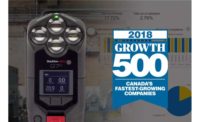As the global workplace safety market continues to grow — estimated to reach $42.96 billion by 2032 with an annual growth rate of 11.8%, according to Polaris Market Research — safety technology provider Blackline Safety Corp. has announced a 50% increase in its fire-hazmat personal and area gas monitor business in the last year alone.
This translates to more than $2 million in total contract value of Blackline’s real-time, cloud-connected safety devices and services, used by hundreds of fire and hazmat, oil and gas, petrochemical, food production, biotech, transportation, utilities, and water and wastewater organizations across North America, Europe, Middle East, Australia and New Zealand.
Crediting the growth to the company’s industry-first product capabilities, Doug Mayer, Blackline Fire Hazmat Business Development Specialist, explained that “Blackline’s No. 1 priority is helping organizations keep their employees and communities safe, and recognizing that every second counts in an emergency. We have reimagined safety solutions for various scenarios – from chemical spills and fires, to floods, gas leaks, explosions, and any other high-risk situation – by enabling organizations to respond with unprecedented speed, accuracy and as-it-happens visibility.”
Blackline’s award-winning G7 personal gas detectors and G7 EXO area gas monitors—built for extremes and the toughest conditions, with GPS-enabled location tracking—provide layers of protection to ensure a critical lifeline during an emergency. Supported by Blackline Live, the company’s powerful, cloud-connected monitoring and analytics platform, the technology enables organizations to view in real time all their workers’ locations and gas readings in the field, and configure their devices, from any Internet-connected smartphone, tablet or computer, no matter how remote the location.
“Imagine being able to position an incident command center and direct responders from anywhere in mere minutes – that’s the game-changing capability of the Blackline Live monitoring platform,” Mayer said. “With quick connectivity and real-time data continuously streaming to the command center, decision makers can immediately understand the situation and risks, and confidently and quickly deploy potentially life-saving responses, including coordinating and communicating with stakeholders like local, state or federal agencies.”
Key features of Blackline’s G7 solutions include:
Real-time connected safety for lone workers/workers in emergency situations: Incident commanders can always see the location of incident responders and monitor team members – as well as variables such as gas exposures, person down, no motion, SOS latch, etc. – from any location.
On-the-go flexibility: Swappable gas sensor cartridges enable users to select single-gas diffusion, multi-gas diffusion or multi-gas pump cartridges for any device. Each device can be configured while travelling to the scene by swapping out the pre-calibrated sensor cartridge rather than the entire device.
Device connection to Vlahi's web- and smartphone-based CERES software: Using Vlahi proprietary, government-endorsed plume dispersion modeling platform, incident leaders can see the size, direction, speed, and spread of released gases to minimize exposure and respond most effectively to protect communities.
Community alerts: In the event of incidents like major fires or chemical spills, the devices’ area monitoring capabilities inform first responders when evacuation or shelter-in-place orders might be needed and help reassure communities they are safe.
Automated analytics: All data collected by Blackline devices can be imported into central control room – or third party – software platforms to analyze incident responses and identify areas for improvement.
“Subjective post-mortems are no longer enough to ensure effective fire and hazmat responses,” Mayer said. “Blackline Safety’s advanced technology allows organizations to actually see what’s happening in the field in real time so they can effectively collaborate with down-range responders in real-time, and also gives them the ability to predict what might happen in the future.”
According to the Fire Department Lieutenant of a major U.S. city, the instantaneous, big picture view provided by Blackline’s safety devices is invaluable. When responding to a dangerous fuel spill last year, for example, the G7 personal gas detectors worn on the scene by the department’s firefighters “proved their worth to us right then and there,” the Fire Department Lieutenant said.
“With the real-time data, we could follow how the incident was progressing…. and being able to hear the radio transmissions and see the location of the responders on the map, we were able to quickly direct and adjust the response remotely,” he said.



